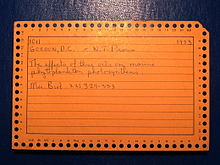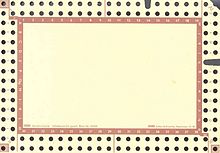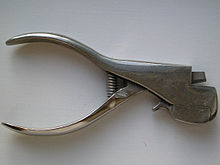- Edge-notched card
-
Edge-notched cards, or McBee cards, were a manual data storage and manipulation technology invented in 1896 and used for specialized data storage and cataloging applications through much of the 20th century. While there were many variants, a popular version consisted of 5 inch by 8 inch paperboard cards with holes punched at regular intervals along all four edges, a short distance in from the edges. To record data, the paper stock between a hole and the nearest edge was removed by a special notching tool. The holes were assigned a meaning dependent upon a particular application. For example, one hole might record the answer to a yes/no question on a survey, with the presence of a notch meaning yes. More complex data was encoded using a variety of schemes, often using a superimposed code. The center of the card might be blank space for information to be written, or contain a pre-printed form.
To allow a visual check that all cards in a deck were oriented the same way, one corner of each card was beveled, much like Hollerith punched cards. Edge-notched cards, however, were not intended to be read by machines. Instead, they were manipulated by passing one or more slim needles through selected holes in a group of cards. As the needles were lifted, the cards that were notched in the hole positions where the needles were inserted would be left behind as rest of the deck was lifted by the needles. Using two or more needles produced a logical and function. Combining the cards from two different selections produced a logical or. Quite complex manipulations, including sorting were possible using these techniques.
Before the widespread use of computers, some public libraries used a system of small edge-notched cards in paper pockets in the back of library books to keep track of them.
See also
References
- Williams, Robert V. (2002). "Punched Cards: A Brief Tutorial". IEEE Annals - Web extra. http://www.computer.org/portal/site/annals/menuitem.8933248930f8c11dbe1fbe108bcd45f3/index.jsp?&pName=annals_level1&path=annals/content&file=punchedcards.xml&xsl=article.xsl. Retrieved 2006-10-30.
- Paper by Douglas C. Engelbart from 1962 Augmenting Human Intellect, discussing use of edge-notched cards to partially model Vannevar Bush's Memex concept.
- The McBee Keysort System for Mechanically Sorting Folklore Data The Journal of American Folklore , Vol. 66, No. 262, Oct. - Dec., 1953
External links
Categories:- Business documents
- Storage media
- Ephemera
Wikimedia Foundation. 2010.



